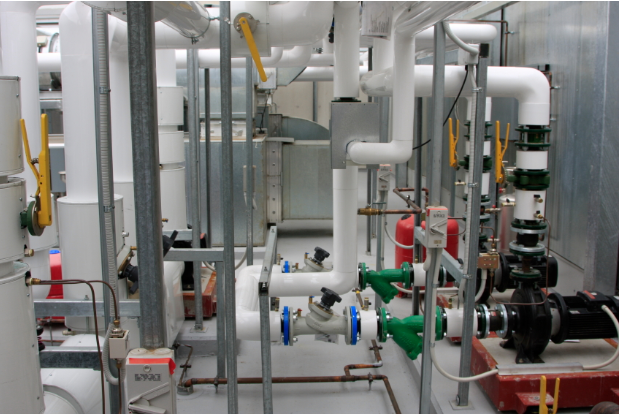Introduction
AD
In the dynamic environment of commercial and industrial facilities, maintaining and modifying complex pipework systems can pose significant challenges. Ensuring uninterrupted operations while performing necessary maintenance or upgrades is often a top priority. One technique that has emerged as an effective solution to these challenges is pipe freezing. By using controlled freezing methods, this technique creates a temporary ice plug in a pipeline, allowing for safe and efficient isolation of specific sections without the need for system shutdowns.
Pipe freezing is widely employed across industries such as water treatment, chemical processing, HVAC, and energy production. It provides a versatile and cost-effective approach to pipeline maintenance, valve replacement, and emergency repairs. This article aims to provide an in-depth understanding of pipe freezing, exploring its applications, benefits, limitations, and best practices for successful implementation in commercial pipework systems.
What is Pipe Freezing?
Pipe freezing is a method used to isolate a section of a pipeline by forming a solid ice plug inside the pipe. This is achieved by applying extreme cold to the pipe’s exterior, using substances like liquid nitrogen or carbon dioxide, to lower the temperature of the liquid inside the pipe to below its freezing point. The resulting ice plug acts as a temporary barrier, preventing the flow of liquids and enabling maintenance or modifications to be carried out safely and efficiently.
The process involves several critical steps:
- Pre-Assessment and Planning: A detailed evaluation of the pipework is conducted to determine the appropriate freezing location. Factors such as pipe material, diameter, and the nature of the liquid must be considered to ensure the process’s effectiveness and safety.
- Preparation: The area around the freeze point is prepared by removing any insulation and ensuring that the pipe surface is clean and accessible. This ensures effective heat transfer during the freezing process.
- Application of Freezing Equipment: A freezing jacket or clamp is placed around the pipe at the chosen location. This equipment is connected to a cooling agent source, usually liquid nitrogen or carbon dioxide, which cools the pipe to the desired temperature.
- Formation of the Ice Plug: As the cooling agent is applied, the liquid inside the pipe begins to freeze. A solid ice plug forms, creating a secure and reliable seal that can withstand the pressure of the liquid in the pipeline.
- Isolation and Work Execution: With the ice plug in place, the isolated section of the pipeline can be safely worked on. This might involve replacing a valve, installing a new fitting, or performing repairs.
- Controlled Thawing and Restoration: After the maintenance or modification work is complete, the freezing equipment is removed, and the pipe is allowed to thaw naturally. The ice plug melts, restoring the flow of liquid through the pipe.
Applications of Pipe Freezing in Commercial Settings
Pipe freezing is a versatile technique with a wide range of applications in commercial and industrial environments. Some of the most common uses include:
- Valve Replacement and Installation: Pipe freezing allows for the replacement or installation of valves without the need to drain the entire system, minimising downtime and disruption.
- Emergency Leak Repairs: In the event of a leak, pipe freezing provides a quick and effective way to isolate the affected section, allowing for repairs to be made without shutting down the entire system.
- Adding New Branches and Connections: When new branches or connections need to be added to an existing pipeline, pipe freezing can isolate the necessary section, allowing for modifications without interrupting the rest of the system.
- Flow Isolation for Pressure Testing: During pressure testing or system inspections, pipe freezing can isolate specific sections, enabling accurate testing without affecting the overall system.
- System Maintenance and Cleaning: Pipe freezing is used to isolate sections of pipework for maintenance, cleaning, or flushing, ensuring that the rest of the system remains operational while the work is being carried out.
Advantages of Pipe Freezing
Pipe freezing offers numerous benefits over traditional methods of isolating pipework, such as system drainage or the use of mechanical plugs. Key advantages include:
- Uninterrupted Operations: By isolating sections of a pipeline without draining or shutting down the system, pipe freezing allows for maintenance and modifications to be carried out with minimal disruption to operations.
- Cost-Effectiveness: Avoiding the need for system shutdowns and draining saves time and money. This can be particularly beneficial in industries where downtime is costly and disruptive.
- Environmental Safety: Pipe freezing reduces the risk of spills and environmental contamination, which can occur during system drainage, making it a safer option for working with hazardous or sensitive liquids.
- Versatility: This technique can be applied to a wide range of pipe materials and liquids, making it suitable for various industrial applications. It is effective for different diameters and configurations of pipework.
- Efficiency: Pipe freezing can be implemented quickly, making it an ideal solution for emergency repairs and time-sensitive projects.
- Safety: When performed by trained professionals using the appropriate equipment, pipe freezing is a safe and controlled method for isolating pipework.
Challenges and Limitations of Pipe Freezing
Despite its many advantages, pipe freezing is not without its challenges. Some limitations and considerations include:
- Suitability of Pipe Material: Not all pipe materials are suitable for freezing. Brittle or corroded pipes may not withstand the stress caused by the freezing and thawing process, potentially leading to damage or failure.
- Type of Liquid: The effectiveness of pipe freezing depends on the liquid inside the pipe. Liquids with low freezing points or those containing high concentrations of antifreeze or chemicals may not form a stable ice plug.
- Pipe Diameter and Wall Thickness: Larger diameter pipes or those with thick walls require more cooling capacity and time to form a stable ice plug. For very large pipes, pipe freezing may not be practical due to the amount of liquid nitrogen or carbon dioxide required.
- Pressure and Temperature Conditions: High-pressure systems pose a challenge for pipe freezing, as the pressure can impact the stability of the ice plug. Additionally, the freezing process can be more difficult in extremely cold or hot environments.
- Space and Accessibility: Adequate space around the pipe is necessary for installing and operating the freezing equipment. In confined spaces or complex pipe networks, this can pose logistical challenges.
- Monitoring and Control: The formation and maintenance of the ice plug require constant monitoring to ensure stability. Any fluctuation in temperature or pressure could compromise the integrity of the ice plug.
Best Practices for Successful Pipe Freezing
To maximise the benefits of pipe freezing and ensure a successful operation, it is important to follow best practices:
- Comprehensive Site Assessment: Conduct a detailed evaluation of the pipe material, liquid type, pressure, temperature, and environmental conditions. This assessment helps determine the feasibility and safety of the freezing process.
- Use of Experienced Technicians: Pipe freezing should be carried out by trained professionals with experience in the technique. This ensures that the procedure is performed safely and effectively, reducing the risk of complications.
- High-Quality Freezing Equipment: Use reliable, well-maintained freezing equipment designed for the specific application. The freezing jackets, clamps, and cooling agents must be suitable for the pipe material and liquid type.
- Continuous Monitoring: The formation and stability of the ice plug should be continuously monitored. Use temperature sensors and visual inspections to ensure that the plug remains stable throughout the operation.
- Emergency Preparedness: Be prepared for potential issues such as unexpected thawing or leaks. Have contingency plans and necessary equipment on hand to address any problems that may arise during the process.
- Controlled Thawing: After the work is complete, allow the ice plug to thaw gradually and naturally. Rapid thawing can cause thermal shock and potentially damage the pipe, so it is important to manage this process carefully.
Future Innovations in Pipe Freezing Technology
As industries continue to evolve, so do the technologies and methods used in pipe freezing. Some of the emerging trends and innovations include:
- Advanced Freezing Technologies: New developments in freezing equipment, such as more efficient freezing jackets and improved cryogenic systems, are enhancing the speed and effectiveness of the freezing process.
- Automation and Remote Monitoring: Automation and remote monitoring systems are allowing for more precise control and real-time data collection during the freezing process, reducing the need for manual intervention and improving safety.
- Wider Range of Applications: Research into the properties of ice plugs and freezing dynamics is expanding the range of applications for pipe freezing, including its use in more complex chemical processes and larger-scale industrial systems.
- Enhanced Safety Measures: Continued innovation is leading to the development of safer and more reliable freezing methods, reducing the risk of complications and improving the overall safety of pipe freezing operations.
Conclusion
Pipe freezing is a powerful tool for the maintenance and modification of commercial and industrial pipework. By creating a temporary ice plug within the pipeline, it provides a safe, efficient, and cost-effective way to isolate sections of pipework for repairs, valve replacement, and other modifications without the need for draining or shutting down the system.
For facilities that rely on continuous operations, pipe freezing offers a practical solution to minimise downtime and maintain productivity. By following best practices and utilising the latest advancements in freezing technology, industry professionals can ensure the successful implementation of pipe freezing services in their facilities.
As demand for efficient and non-intrusive pipeline maintenance techniques grows, pipe freezing will continue to play a vital role in the management and upkeep of commercial pipework systems. With ongoing innovations and a focus on safety and efficiency, the future of pipe freezing looks set to provide even greater benefits and versatility for industrial applications worldwide.









